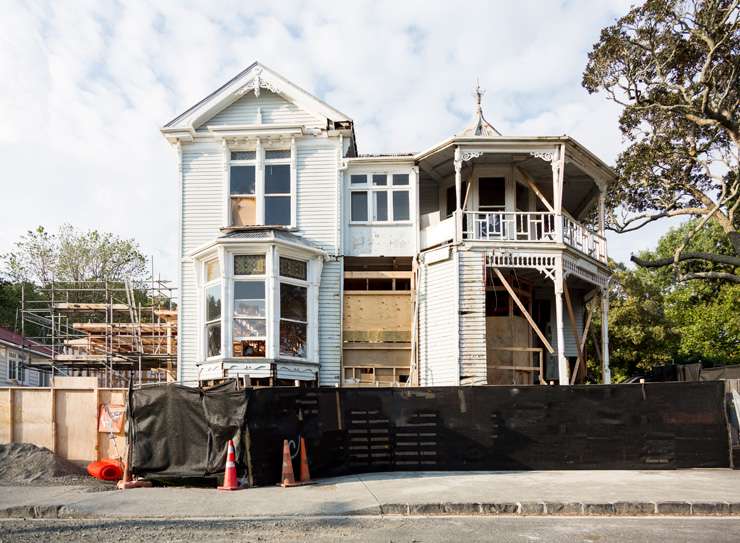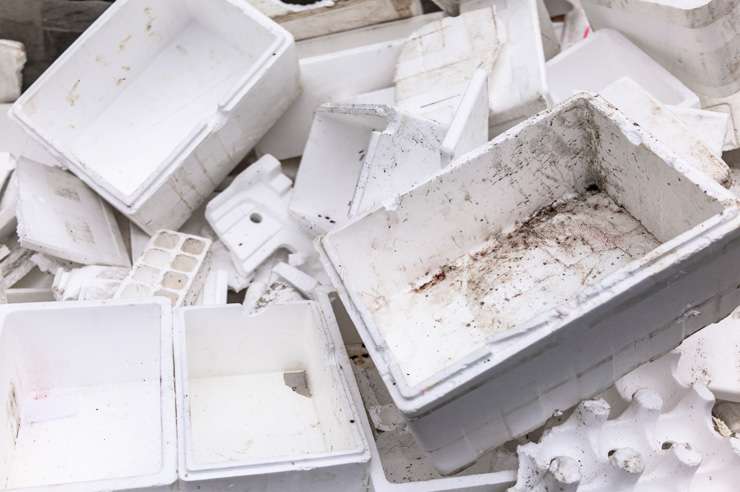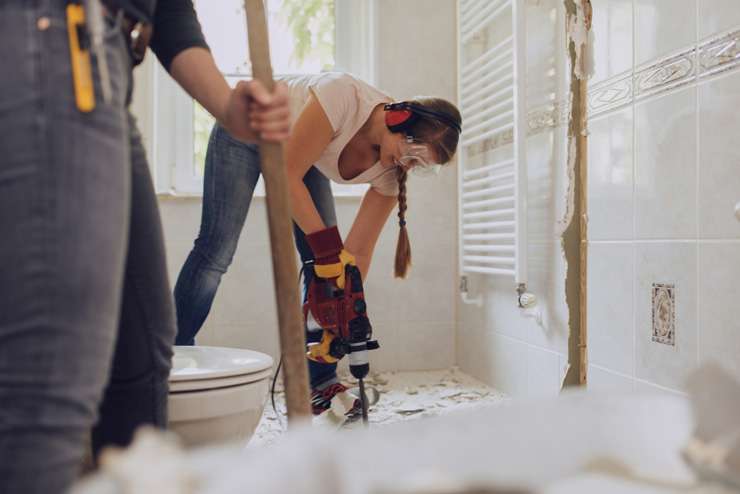Dream renovations are pumping carbon into the environment faster than anyone can say “designer kitchen”, experts have warned.
Renovations, if done recklessly, can have a huge impact on the environment. Even the ones that are carefully planned may not have prioritised sustainability. Emissions from the construction industry increased by 66% in the decade from 2007 to 2017, according to the New Zealand Green Building Council, and the built environment is responsible for 20% of the country’s carbon footprint.
The vast majority of building consents are for renovations, says Mark Roberts, senior waste planning advisor at Auckland Council. “The waste that's associated with those projects [requiring consent] is quite hidden. On top of that you have all the renovations that don’t require consent.”
Start your property search
Reusable or recyclable materials along with perfectly salvageable offcuts are piled high in skips and sent to landfill.
Whilst renovations to bring houses up to healthy homes standards are likely to be sustainable, renovations for aesthetic reasons are often not.

Climate change is rarely on homeowners’ radar when they carry out a renovation. Photo / Getty Images
Basic maintenance renovations to save it from demolition, and upgrades to insulation, better glazing and other improvements to the thermal properties, are positive for sustainability, says Roberts. “From a carbon sense if you can reuse a building or reinvigorate it, refit it without demolishing, there has to be a real carbon benefit.”
That doesn’t extend to dream kitchens, bathrooms, extensions and general beautification for beautification’s sake, no matter how much owners try to greenwash their renovation with sustainable materials. The effect of renovations on climate change is rarely on homeowners’ radars, says Roberts.
“There is some kind of ignorance out here. You can understand that because [renovation] is not something you do every day. You may know the effect of your car every day and the effect on your petrol bill each week. You may only do a renovation a few times in your lifetime.”

A lot of polystyrene can end up going to landfill as a result of a home renovation if homeowners don’t plan ahead. Photo / Getty Images
Roberts says unless homeowners specifically demand it of architects and builders, the renovation is unlikely to avoid problematic building materials which create issues in the environment such as polystyrene and MDF.
Some do become aware of the impact of their renovation because they are still living in the home and can be quite shocked when they realise how much waste a renovation produces and that it is going to landfill in their skips, flexible, and builders trailers. “People mention this to us often,” he says.
Colmar Brunton research for Auckland Council found that there was no silver bullet for changing behaviour around construction and demolition waste. Money tended to trump all.
10 reasons your home renovation could hurt the planet
1. Embedded carbon. Our desire to have the perfect home is creating a body of carbon emissions that will never be mitigated by energy savings.
2. Skips to the tip. It’s an incredibly rare sight to see a renovation where everything from offcuts to plastic wrap aren’t just jumped in the skip. Much of the contents of skips are salvageable. Yet homeowners and builders alike can’t be bothered separating materials out and finding appropriate ways to reuse or recycle them. One of the big problems, says Roberts, is there is a widespread lack of knowledge of what the alternatives to skips and landfill is. The pressure to get the job done means many builders don’t take the time to learn more. “The skips going to landfill from renovations are the problems of embodied carbon worse by not using resources efficiently,” says Matthew Cutler-Welsh, business development manager at the New Zealand Green Building Council. “Perfectly salvageable materials are sent to landfill because some can’t be bothered separating them out and finding appropriate ways to reuse or recycle them. The best way to reduce waste is to not create it in the first place. We have some Homestar and Green Star [building] projects diverting as much as 90% of their waste from landfill.”

Recycle as much waste materials as you can. Just sending waste to landfill will end up costing the environment. Photo / Getty Images
3. Cheap materials are more popular. Architects and homeowners are not opting for lower carbon alternatives because money is king.“Costs are such a big factor in anything to do with building,” says Cutler-Welsh. “When a builder is tendering or quoting for a job, they're going to be trying to keep those costs down and if they don't have to they're probably going to take the cheapest option, unless it’s a big part of the motivation or part of the values of the client.”
4. Offcuts galore. It’s not simply the old materials being ripped out of a reno, or the products being used in the build that can be counted in carbon. One of the big environmental problems with renovations is that there are no well-developed mechanisms to get offcuts to third parties who can use them. This issue was highlighted in an experimental skip-less build in Auckland last year. Offcuts of many materials could have a second chance at life if people tried. Cutler-Welsh did an experiment with Pink Batts offcuts, or part bags, which often find their way into skips. He put the word out to builders that he was collecting these unwanted materials “They are just a pain. You can't return to the merchants. I collected enough to insulate a roof for a not-for-profit that provides housing for transient and disabled people. It just goes to show how easy it is to find a use for some of these materials, rather than chucking them out.” A growing number of for-profit businesses and social enterprises take offcuts and leftover building materials.
5. Renovations are cyclical and happen every 20/30 years if not more frequently. The carbon added from aesthetic renovations may add up to more than an entire build over time, says Roberts. “If you take a house that produces four tonnes of waste, it wouldn’t be inconceivable that you produce another couple of tonnes 10/20/30 years down the track and then again another couple of times [in the home’s life].”

Look at the materials you plan to use in your renovation. Can any of them be substituted for more sustainable products? Photo / Getty Images
6. Excusitis. Integral to greenwashing is the excuses people make as to why their build is environmentally friendly. "I'm making it more energy efficient", "It's adding insulation", "I eat organic, so I can trade that off my emissions from the home". “Often those excuses are based on convenient myths. People will go, ‘oh mate, it’ll cost too much’, ‘it’ll take too long’, ‘it’ll be too much trouble’, ‘yeah, we can’t do that, it’s unworkable’,” says Roberts. “They find a convenient excuse. That’s the refreshing thing about [sites such as 40 Titirangi] is that attitude doesn’t exist. The attitude is: ‘how do we do this’.”
7. Lack of awareness. Homeowners are often blissfully unaware of the climate impact of their builds. It takes a very single-minded builder or homeowner to make that work. If homeowners were aware of the climate impact, it’s likely they could also save money. AUT estimates the average new-build wastes $31,000 of materials. The equivalent figure for renovations would be pro rata.
8. No waste management plans. Waste management plans are not compulsory, although proposed amendments to the Building Act announced in December say some building and demolition work will require waste minimisation plans. In research conducted for Auckland Council by AUT, the researchers concluded that waste minimisation plans are feasible, and desirable and will work to reduce construction and demolition waste across the city. New Plymouth and Hamilton have introduced such plans already.
9. A lack of stewardship. With no waste management plans there is little incentive for stewardship - ensuring that manufacturers recycle offcuts or materials at the end of their life. Stewardship where renovations are new-builds are designed in a manner where they can be deconstructed at the end of their lives, and the materials reused. This is becoming common overseas, although not here, except with social housing, says Roberts. “Kāinga Ora have been very active in that space and have created a deconstruction panel. That is having ripples across the industry.”
10. Paying too little for waste. Homeowners and builders in New Zealand may think it costs a packet to dump their waste. The reality is that ‘polluter pays’ is a long way off in Aotearoa. In Sydney, homeowners pay $150 per tonne for waste disposal. In Auckland that figure is $20, says construction and commercial waste manager David Knight of Junk Run. The government has gazetted to increase it progressively to $60 per tonne in July 2024. The higher the waste levy, the more likely markets will develop to reuse and recycle waste, says Cutler-Welsh. “It just goes to show how easy it is to find a use for some of these materials, rather than chucking them out.”










































































